Captain Brian Colden Antill Pockley MiD
Australian Army Medical Corps, Australian Naval and Military Expeditionary Force
by Robert Simpson
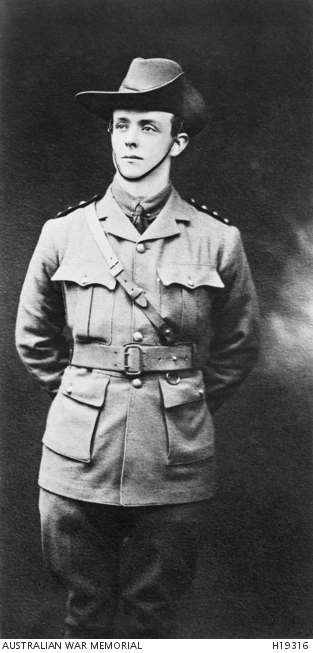
Brian Colden Antill Pockley was born on 1890 in St. Leonards Sydney, New South Wales, a son to Francis Antill Pockley and Helen Clara Hooke. He was the third child and middle son of the children and had two brothers, Francis Guy Antill (born 1888) and John Graham Antill (born 1892), and two sisters Phyllis Mary Antill (born 1886) and Helen Dorothy Antill (born 1895). Francis was a doctor who was an eye specialist. He was one of the North Shore’s earliest doctors (later to become a leading ophthalmic surgeon). Doctor Pockley was an avid early motorist. Brian’s grandfather was Robert Francis Pockley, who was a Captain of ships that sailed from England to Australia and back. Robert moved to Australia and married Selina Eliza Antill (from where Brian gets his unusual middle names). Selina’s father was Henry Colden Antill, who had been born in the USA, but migrated to and married in Australia. Henry’s parents were John Antill and Margaret Colden. John’s father was Edward Antill a prominent colonial politician in the New Jersey colony. John served with the British during the American Revolution as a Major, while another son Edward, joined the Continental Army and was promoted to Lieutenant-Colonel. Margaret’s father, Alexander, was also involved in the revolution.
Brian completed his early education at Sydney Church of England Grammar School from 1902 to 1908. His father had presented an annual prize on moral qualifications since 1904. In his time at this school he was Prefect, Pockley Prize man (in 1908), Captain of Football, won Football and Athletic colours. He was quite a remarkable athlete, being in the First XV, Captain of Football and winning the Honour Cap. He won the Championship Shield for two successive years and when captaining the football team, it was unbeaten for two years. Other sport he was involved in were rowing, swimming, boxing and ju-jitsu wrestling. The New South Wales Junior and Senior Public Examinations roll lists Brian as sitting the senior exam in 1908, but it says for subjects passed that he “qualified for admission to Dept. of Engineering”. (Probably an error in transcription and should read Faculty of Medicine). He was a Lieutenant in the G.P.S. Senior Cadets in 1908-9 and was skilled at shooting.
At the University of Sydney, he studied medicine from 1909 to 1913 while staying at St. Paul’s College. Brian gained a double Blue for football and athletics in his first year, he was Vice-President of the Medical Society in his last year and was on the committee of St. Paul’s College for 3 years. He was working as a medical practitioner upon completion of his M.B. degree, at Sydney Hospital as junior resident medical officer.
When he was 19 he visited New Zealand, and returned to Sydney on 24th September from Auckland.
In the 1913 electoral roll he was listed as living at 26 Liverpool St Ashfield and was a medical student. Another roll of the same year has him at his parent’s house at Burns Rd Ryde as a medical student.
Brian applied for a commission in the Australian Imperial Force in the Australian Army Medical Corps on 14th August 1914. He gave his address as Graystanes, Wahroonga which was the address of his father Dr F Antill Pockley who was listed as next of kin. (The house is now named Mount Alverna after being purchased by the Catholic Church in 1950). The address was later changed to 227 Macquarie St. Sydney. Brian was described as being 5 foot 9 inches tall, weighed 11 stone 7 pounds, had a chest measurement of 38 inches (apparently he had a 9 inch expansion) and normal eyesight. As a Captain, he was appointed to the Australian Naval and Military Expeditionary Force (ANMEF) (Tropical Unit) which left Australia on 19th August 1914 for German New Guinea.
As part of the first Naval Brigade landing force, he landed at Kabakaul on 11th September 1914. While advancing towards a German wireless station, Able Seaman William Williams was shot in the stomach. Pockley attended to him and then got Stoker Kember to carry Williams to the rear. He gave him his Red Cross armband (brassard) to ensure they were not shot at. While attending another wounded seaman, despite being warned not to, Pockley was shot and wounded. The Germans took him for an ordinary soldier. Both Pockley and Williams were taken aboard HMAS Berrima. Williams died first, becoming the first Australian casualty of the war. Pockley succumbed later, becoming the first Australian officer to fall in the Great War.
S. S. Mackenzie (author of The Australians at Rabaul) wrote, “Pockley’s action in giving up his Red Cross badge, and thus protecting another man’s life at the price of his own, was consonant with the best traditions of the Australian army, and afforded a noble foundation for those of Australian Army Medical Corps in the war.” In the University of Sydney Roll of Service it is also recorded “As he lived his life…so he met his death… brave, cheerful, unselfish to the last, leaving behind a record carved in pure gold.” – Hermes, November, 1914.
Brian died of wounds on 11th September 1914 at Kabakaul, Papua New Guinea and was buried originally at Herbertshohe cemetery (now Kokopo), East New Britain, Papua New Guinea on the same day. Later his remains were reinterred in Rabaul cemetery on 11th July 1919 with full Naval and Military Honours. In 1950, his grave was relocated to Rabaul War Cemetery (Bita Paka). He is commemorated on panel 188 at the Australian War Memorial. Brian is also listed in the Book of Remembrance of the University of Sydney in the Great War 1914-1918.
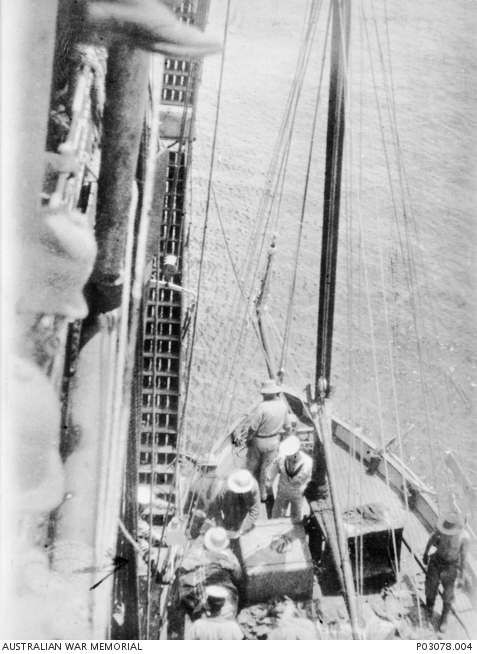
Members of the Australian Navy and Military Expeditionary Force (AN&MEF) bringing Captain Brian Colden Antill Pockley, the medical officer, on board HMAT Berrima, his face is covered by his pith helmet.
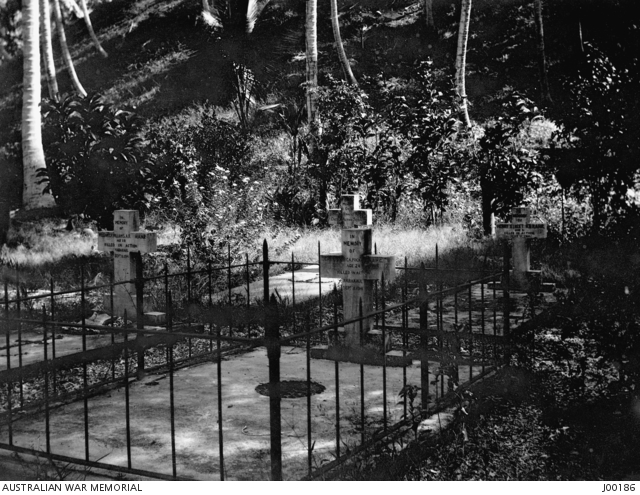
The 1916 grave of Captain Pockley and other men killed in 1914. The iron railing fence around the grave of Captain Pockley was provided by an uncle, also a medical doctor and named Pockley.
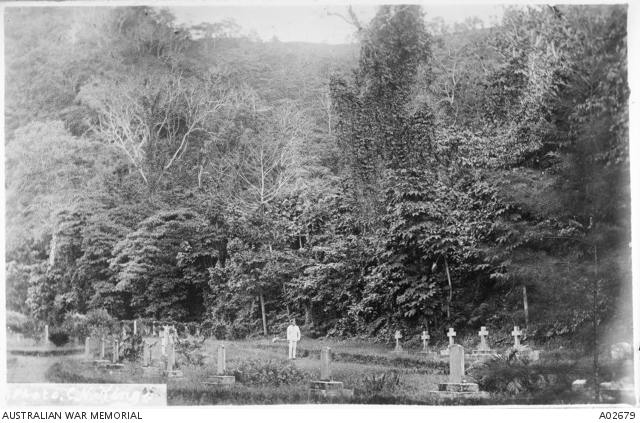
The graves of Lieutenant Commander Elwell, Royal Navy (RN), Captain Brian Colden Antill Pockley, Australian Army Medical Corps (AAMC), A B Courtney (Walker), and A B Street, who fell at the capture of Kabakaul, German New Guinea, taken in 1914.
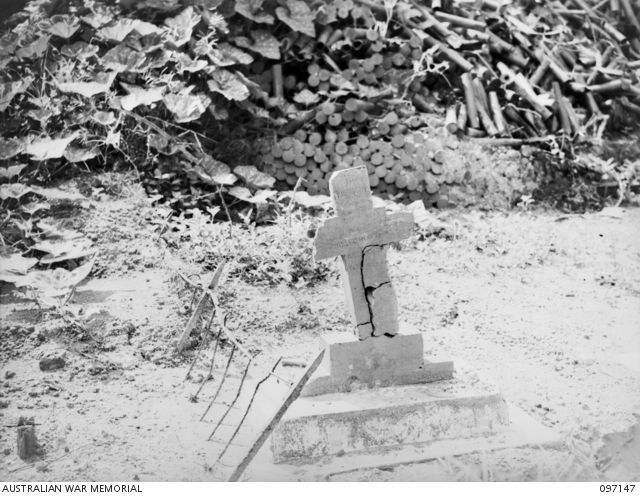
A picture of his grave taken in 1945 at Rabaul cemetery. The Japanese damaged many AIF headstones in WW2.
He was mentioned in despatches by Vice Admiral Sir George Patey as being commended for services in action during the operations against the German Possessions in the Western Pacific, which was promulgated in the London Gazette on 11th January 1916, page 449, position 3. Unfortunately they have spelt his middle names incorrectly as Colder Ampill. His father received a letter from King George V in December 1914, reading with great interest and pride the account and the noble manner of his death and also conveying his sympathy and regret for his loss. The Sydney Morning Herald published his obituary on 14th September 1914 which again described his brilliant career as a student and athlete and noting the speech of the rector of St. Andrew’s Church of England at Wahroonga. Brian attended there and the Reverend told of his moral and upright character and noble example.
On 25th September 1919 his father wrote to Base Records expressing his disappointment that no one informed him that they had moved Brian’s remains without advising him. He told them he had visited the original grave 4 years ago and was going to bring the remains back to Sydney, but when he saw how it presented and was being maintained, he decided his remains should stay there. He was surprised and had communicated with the Secretary of Defence and Brigadier General Johnson on the matter and said if he had known, he would have brought the body back to go to the family burial ground. His address at the time was 227 Macquarie St. Sydney. But a letter had been written on 30th August explaining all the details involved with the moving of the remains to that address, although another letter on 10th September was sent to Grayslanes.
His father signed for Brian’s Commission Form on 29th September 1920 (his secretary signing for him as he was overseas at the time), the Mention in Despatch certificate on 20th November 1920, the Memorial Scroll on 8th July 1921 and the Victory medal with one Oak Leaf attached on 22nd June 1922. His Memorial Plaque was signed for on 30th April 1923, but there was a problem with it. His first name was written as Brien and in the paperwork in his service records they seem to promote the error by saying it should be Brien, not Brian. His father probably propagated the problem, as in his letter to Base Records he writes “The name on this is wrongly inscribed, “Brian” being incorrectly spelt “Brien”, which probably could have been worded clearer. He was asking for it to be corrected. Another note said that in all the records they had his name was spelt Brien, which appears to be an error on his original application forms where someone else has re-written his full name. A letter was sent out, asking for its’ return, which it was on 24th April 1923, and hopefully corrected to the right forename. His 1914-15 Star and British War Medal were also sent, but no acknowledgement is in his service file.
The Police Gazette of 10th March 1915 has an entry relating to the loss of a pair of binoculars belonging to Brian. They were lost or stolen at Rabaul and may have come to New South Wales. They had his name inscribed on them and the case.
Forms relating to the permanent memorial for Brian were posted to his father at Grayslanes on 20th December 1919, but had not been returned to Base Records, so they sent out more on 8th February 1921 and asked if he could fill them out and return as soon as possible.
John Graham Antill Pockley also served in the war. He joined as a Private with his friend Elliott Slade in 1915 and were on the hospital ship Karoola. On return of the ship they both did NCO’s and Officers’ schools in Australia before going to England for more training. After receiving their commissions they were sent to France with the 33rd Battalion. They were both killed on 31 March 1918. John was married and left a wife and child.
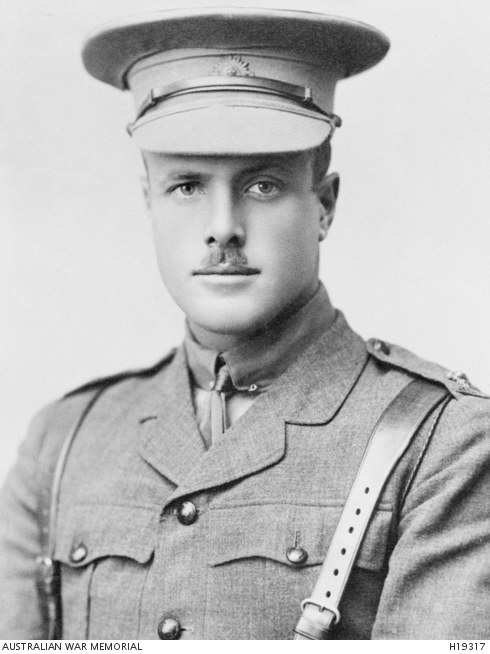
John Pockley.
Helen remained unmarried and died in a car accident near Bowral.
Phyllis married Lieutenant “Peter” Clinton Danby, who served in both World Wars and was later Vice-Admiral Sir Clinton Danby KBE CB. He was also at HMAS Cerebus and commanded an Australian Squadron on HMAS Melbourne in the mid-1920’s.
Francis Guy was also a doctor and a well-known eye specialist and had a farm called “Pylara” near Goulburn.
Reverend Dr Radford produced a booklet in memory of Brian and any proceeds from sales were to be given to the Red Cross. A memorial tablet was placed in the Sydney Hospital and unveiled on 23rd December 1915 to commemorate Brian and described how he died.
In 1922, Dr Pockley presented a fountain to the Grammar School in memory of his sons. He also endowed the Pockley Prize permanently as the Brian Pockley Memorial Prize in 1914 in memory of his son.
Brian’s Headmaster wrote of him: “I always considered him as approaching as near to my ideal schoolboy as any boy in my experience. Work and games alike he displayed a splendid keenness and an admirable temper, and won high honours for the School and for himself, and the unconscious influence which he exercised was in the direction of an upright manliness. As a Prefect he helped me more than he was aware of, by loyalty, by respect to duty, and by charm of manner. I trust that for his family as for us there may be much consolation in knowing that his beautiful life and noble death have been of infinite worth to his day and generation, and that for himself, though his days were short, they were days of happiness and honour”. His father gave Shore a memorial drinking fountain in the playing fields, and a window in the north wall of the chapel is dedicated to him. It is the first of a series, and represents St. George. Brian’s portrait is used for the face of St. Luke, “The Beloved Physician”.
The National Archives of Australia has documents pertaining to his effects, and honours and awards report.
His medals are the 1914-15 Star, British War Medal and Victory Medal with oak leaf.
The museum does not hold anything for him, the story was done for a trip to Rabaul on the centenary of AN&MEF Force.
ANZAC Biographies
On our website you will find the biographical details of ANZAC (as well as British) servicemen & women
whose medals or other memorabilia form part of the collection belonging to the
Maryborough Military & Colonial Museum,
Maryborough, Queensland, Australia.